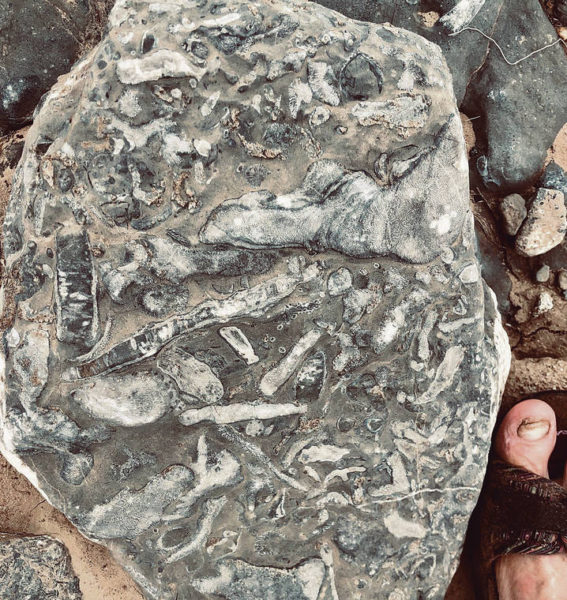Published in the Ocean Watch column, Honolulu Star-Advertiser © Susan Scott
May 25, 2019
Townsville, Australia >> By the end of May, cyclone season has usually passed here on Australia’s east coast. Not this year. Upon our arrival a cyclone in the far north, followed by a tropical storm, prevented us from sailing our 37-foot ketch, Honu, to the Great Barrier Reef.
So after visiting Townsville’s flying foxes and enjoying the marina’s archerfish, kookaburras and brush-tailed possums, we decided to visit another of Australia’s great barrier reefs.
Yes, the famous 1,200-mile-long stretch of reefs and islands along Australia’s east coast is not the area’s first. Other expanses of corals, and the creatures associated with such structures, thrived here about 380 million years ago during the geologic period known as the Middle Devonian.
 Fossilized marine animals from the Devonian Era,
Fossilized marine animals from the Devonian Era,
between 410 million and 380 million years ago,
as seen at Big Bend Reefs today.
©2019 Susan Scott
DURING THIS era Australia was still a mostly underwater appendage of the supercontinent Gondwana. When the sea level dropped and tectonic plate movement created Australia, some of the former great reefs became fossils.
One these ancient reefs is a little-known group of limestone outcrops called the Big Bend Reefs, part of a line likely even longer than the current one. Because Big Bend lies about 100 miles inland from Townsville, a visit required a road trip.
I’ve wanted to see the Big Bend Reefs since I read about them three years ago in a book called “A Reef in Time: The Great Barrier Reef From Beginning to End,” by J.E.N. Veron (Harvard University Press, 2009). Veron, former chief scientist with the Australian Institute of Marine Science, describes the ancient reefs but doesn’t say how to get there.
AFTER SOME internet queries, I found a blog describing a remote campsite called Echo Hole that featured ancient coral fossils. The blogger gave directions.
The route required leaving our rental car near the bank of a fast-moving stream off the Burdekin River. After wading across, we hiked a mile in sand and then bushwhacked through downed trees and thick ground cover, grown dense after recent floods.
Just as I was about to give up, Craig found the ancient lava flow mentioned in the article. As we picked our way across the cracked basalt, fossils began to appear in large sheets and in small rocks.
HOLDING IN my hand a bunch of perfectly preserved, 380 million-year-old marine animals gave me a surprising sense of peace. These creatures died during Earth’s second mass extinction, followed by three more, yet the fossils here, and others I’ve seen around the world, look much like today’s corals, clams and snails. It may have taken millions of years between each extinction, but eventually coral reefs reappeared, not by recolonization of survivors, but by the evolution of new species.
Today, as we race toward a human-caused sixth mass extinction, it’s comforting to know how persistently conditions on Earth favor life. Homo sapiens may not be around to see it, but it will happen.